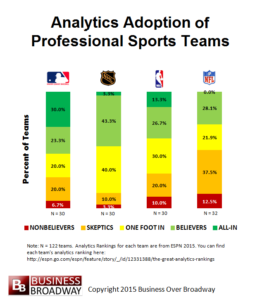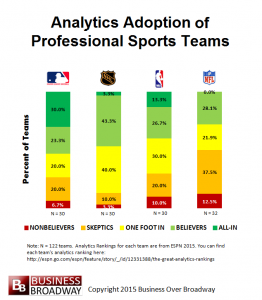
Regardless of which sport you prefer, today is the greatest reminder in years of a fact that is clear and undisputed — sports is big business. When so much money is at stake, every decision can have a major impact on a team or individual’s bottom line, both in terms of wins/losses and revenue. Not long ago, major decisions were made by a handful of experts based on gut instinct and intuition. Today, the most successful athletes and teams are using data analytics to guide decisions like these:
- Which players to draft or acquire (considering budget or salary cap constraints)
- Which plays/approaches are the most effective (based on empirical data) in every possible game situation
- How to exploit opponents through analysis of tendencies, strengths, and weaknesses
- How to maximize revenue through fan engagement – attendance, concessions, merchandising, pricing for pay-per-view events
The graphic below shows the level of analytics adoption among teams in the four major US Sports leagues — MLB, NHL, NBA and NFL. Baseball has the highest levels of teams that are “all in.” In other words, these teams have fully adopted analytics as a core business practice. Baseball has always been highly statistics driven and arguably the pioneer for analytics in professional team sports. The 2003 Michael Lewis book Moneyball popularized the use of analytics for competitive advantage, allowing small market teams to stay competitive by targeting undervalued players. In Basketball, analytics around scoring efficiency have completely changed the way the game is played (sharp increases in the number of 3 point field goal attempts) and the players required to execute the changing strategy. Hockey is poised for a big jump in adoption in the coming years. Football, by far the most popular US sport, surprisingly lags behind the others in adoption despite extensive use of analytics for player selection and in-game strategy.
While I’m rooting for my favorite team, fighter, and even a preferred horse this weekend, I’ll keep in mind the role of data science and analytics in all aspects of the fan experience. Successful athletes use data to study opponents, leverage advantages, and increase their own performance. Successful franchises and events use data to increase fan loyalty, engagement, and maximize revenue.
Like sports franchises, many forward-thinking associations are leveraging the power of their data to advance their mission. For example:
- What is the best use of limited resources for new member acquisition?
- What prospective products or services are likely to be successful? What is the best way to market them? What is the optimal pricing model?
- What are the key metrics to consider in member engagement and how can we improve them?
Combined with the wisdom and experience of senior leadership, data analytics enables the most effective strategic decision-making for associations.



